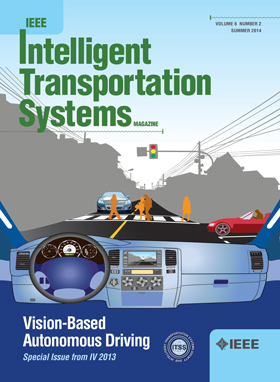A Hierarchical Controller for Connected Truck Platoon: Analysis and Verification
IF 8.4
1区 工程技术
Q1 ENGINEERING, CIVIL
IEEE Transactions on Intelligent Transportation Systems
Pub Date : 2025-04-18
DOI:10.1109/TITS.2025.3556465
引用次数: 0
Abstract
This paper proposes a novel hierarchical controller for connected truck platoons. To this end, the predecessor following topology is used to characterize the communication connectivity between connected trucks. Then, a longitudinal efficient controller consisting of upper-level and lower-level controllers is proposed. In particular, the upper-level controller is designed based on the kinematic model to handle the car-following interactions between connected trucks and delays in communication and input. The lower-level controller comprises a feedforward and a feedback control law. The feedforward control law converts the desired acceleration from the upper-level controller into the vehicle throttle or braking pressure using the inverse dynamic model, while the feedback control law compensates for the control error caused by unknown vehicle parameters. In addition, in the linear region, the internal stability is analyzed based on the second-order kinematic model using s-domain analysis and linearization method, respectively. Then, the string stability is proved. The influence of parameters on the stability performance is extensively discussed using the stability diagram. Finally, the feasibility of the proposed controller is verified via co-simulations in PreScan and TruckSim, in terms of acceleration, velocity, and spacing error profiles.一种联网卡车排的层次控制器:分析与验证
提出了一种新型的联网卡车排分层控制器。为此,使用前代拓扑来描述连接的卡车之间的通信连通性。然后,提出了一种由上、下两层控制器组成的纵向高效控制器。特别是,基于运动学模型设计了上层控制器,以处理连接卡车之间的跟车交互以及通信和输入的延迟。下一级控制器包括前馈控制律和反馈控制律。前馈控制律利用逆动力学模型将上位控制器的期望加速度转换为车辆油门或制动压力,反馈控制律补偿未知车辆参数引起的控制误差。此外,在线性区域,基于二阶运动模型,分别采用s域分析和线性化方法对内部稳定性进行了分析。然后,证明了弦的稳定性。利用稳定性图广泛讨论了参数对稳定性性能的影响。最后,通过在PreScan和TruckSim中进行加速度、速度和间距误差分布的联合仿真,验证了所提控制器的可行性。
本文章由计算机程序翻译,如有差异,请以英文原文为准。
求助全文
约1分钟内获得全文
求助全文
来源期刊

IEEE Transactions on Intelligent Transportation Systems
工程技术-工程:电子与电气
CiteScore
14.80
自引率
12.90%
发文量
1872
审稿时长
7.5 months
期刊介绍:
The theoretical, experimental and operational aspects of electrical and electronics engineering and information technologies as applied to Intelligent Transportation Systems (ITS). Intelligent Transportation Systems are defined as those systems utilizing synergistic technologies and systems engineering concepts to develop and improve transportation systems of all kinds. The scope of this interdisciplinary activity includes the promotion, consolidation and coordination of ITS technical activities among IEEE entities, and providing a focus for cooperative activities, both internally and externally.
 求助内容:
求助内容: 应助结果提醒方式:
应助结果提醒方式:


